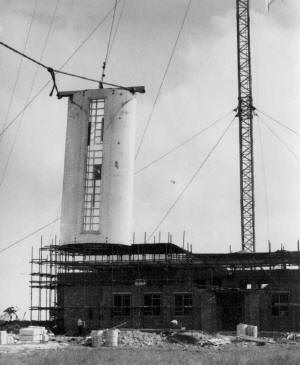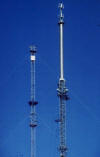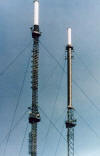|
BBCeng.info
Recollections of BBC engineering from 1922 to 1997 |
The British Broadcasting Corporation web site is: www.bbc.co.uk |
Transmitter Projects - Reminiscences
The Background to and Engineering of VHF/FM Radio Broadcasting in the UK
By Geoff Platts
Introduction
Starting in the 1920s the number and powers of transmitters operating in the LF (30kHz-300 kHz) and MF (300kHz – 3MHz) Bands in the UK and the rest of Europe increased rapidly, resulting in mutual interference, particularly at night when long distance propagation in these bands is enhanced.
After World War 2 a conference, held in Copenhagen in 1948, allocated frequencies, transmitter powers and radiation patterns to minimise such interference. Nevertheless interference continued to increase as new transmitting stations were opened and higher powers used, so much so that manufacturers began to produce receivers with audio bandwidths restricted to 3 or 4kHz to minimise interference from adjacent channel transmitters, although this severely degraded the reproduction of music, which ideally requires audio frequencies up to about 15kHz.
Similar problems were being encountered in the Eastern United States and some experimental transmissions using FM with carrier frequencies in the range 40-50 MHz were made prior to World War 2.
In 1947 an International Telecommunications & Radio Conference, held in Atlantic City, allocated the frequency band 87.5- 100 MHz for broadcasting in Europe. However initially only the Band 88-94.6MHz was allocated to broadcasting by the UK Government, though this was later extended 108MHz.
Initial Tests and Anticipated Requirements
After World War 2, whilst the priority aim was to extend TV coverage to the whole of the UK, BBC Research Department carried out a series of laboratory tests and low power field trials. These tests indicated :-
- That for similar transmitter carrier powers, frequency modulation with
a maximum deviation of + or – 75kHz together with pre-emphasis of the
higher audio frequencies (and de-emphasis in receivers) resulted in an
improvement in received Signal to Noise ratio of about 23dB relative to
amplitude modulation, with transmitters drawing a constant and reduced
power from public electricity supplies.
- Similar erps for Band 1 TV and Band II VHF/FM radio services would
result in similar coverage , hence in general no additional sites would be
required for VHF/FM radio Services.
- Horizontally polarised transmissions with the directional characteristics of horizontally polarised receiving antennas would offer protection against co-channel transmissions and reduce vehicle ignition interference.
Other considerations favouring the choice of horizontal polarisation was the desirability of using antennas which would minimise wind loading and with radiation patterns largely unaffected by mast stay wires on masts to be erected for the expanding TV service. Lattice masts - said to be derived from flame stacks at oil refineries – were erected at Sutton Coldfield, Holme Moss, Kirk O’Shotts and Wenvoe. These masts, of 9ft triangular section to a height of 600ft, carried structural cylinders with a diameter of 6ft 6ins surmounted by two tier cantilever TV antennas bringing the total height to a nominal 750ft. The lower 84ft of the cylinder was equipped with 32 vertical slots fitted with Perspex windows, to prevent the ingress of snow, arranged as four stacks of eight. The TV Service from these sites opened respectively on 17/12/49, 12/10/51, 14/3/52 and 15/8/52, but the slots for future FM Radio Services were not equipped with any ancillary fittings or feeders at this time pending the outcome of further development work.
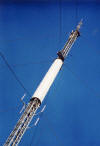 |
The completed 4stack 8tier 60kW erp VHF/FM antenna at Meldrum, Aberdeenshire |
In early 1949 a site was acquired at Wrotham in Kent for further tests with the eventual aim of providing VHF Radio Services in South East England. A mast and slotted cylinder similar to those at the main TV stations was erected and equipped with internal screening for the slots, distribution feeders and duplicate 5ins. copper co-axial feeders connected to the upper and lower halves of the antenna. A long line co-axial feeder combining unit, housed in a low building remote from transmitters, was used to combine the outputs of two 20kW transmitters, one amplitude modulated and the other frequency modulated, and the output divided between the two main feeders.
Test transmissions commenced in May 1950 and subsequently confirmed the choice of frequency modulation as the future standard and in 1952 it was estimated that 75 transmitters would provide National coverage at a capital cost of £3,500,000 with operating costs of £800,000, both these costs expected to rise 2.5 times if amplitude modulation was used, though it was estimated that FM receivers might be 5% - 15% more expensive than AM receivers.
In July 1954 the Government formally authorised the BBC to start work on a plan for National coverage with three programmes using frequency modulation, and on 2nd May 1955 the Wrotham transmitting station started to provide such a service with 20kW of power for each service producing erps of 120kW.
The frequencies chosen for any particular site were spaced at 2.2MHz intervals to minimise the number of low level intermodulation products both within and outside the frequency band allocated to VHF/FM, the former to facilitate RBR (re- broadcast reception) on future dependent relay stations and the latter to minimise interference with other users of the frequency bands adjacent to that allocated for radio broadcasting.
Implementation of the Transmitter Network
Whilst Research Department specified the locations of transmitting sites, radiation patterns, heights of antennas and erps, Transmitter Capital Projects Department carried out development work and acquired all the hardware, generally from contractors with no technical expertise, supervised installation on site and set the antenna and feeder systems to work, including receiving notch and splitting filters at the later stations using RBR for programme feeds.
The antennas at the medium power (60kW erp) stations were electrically similar to those at the high (120kW erp) Stations, but comprised 32 quadrant aluminium slotted panels attached around 4ft square masts; 4ft 6ins in the case of the 750ft mast at North Hessary Tor.
The combining equipment at the high and medium power transmitting sites commissioned in the early part of the programme were supplied by Marconi and STC, but at the later lower power sites by Transmitter Capital Projects Department.(TCPD).
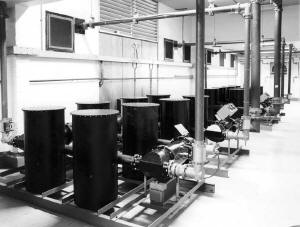 |
A pair of Combining Units at Sutton Goldfield used to combine the outputs three pairs of 10kW VHF/FM transmitters |
To ensure continuity of service a policy of splitting the antennas into upper and lower halves, with pairs of transmitters was followed, with the exception of Wrotham where the original pair of 20kW transmitters (one modified) was used with 4 kW reserve transmitters, for two of the three services.
The main feeders at the 120kW erp and 60kW erp stations, with the exception of those at Wrotham, consisted of flanged 12ft lengths of 3¼ ins diameter 50ohm co-axial feeders, associated anchor points and expansion joints manufactured by Marconi.
Operational Problems
Most of the operational problems were associated with the 3¼ inch copper main feeders, in which the inners were held concentric with the outers by means of ceramic pegs protruding from pockets in the inner arranged in a helix at 1ft intervals These feeders had to allow for the differential expansion between copper and the steel of mast; also between the inners and outers of the feeders, as the inners run at a higher temperature than the outers as a consequence of the skin effect and differing diameters. Disc insulators were used every 120ft to anchor the inners to the outers, with expansion joints immediately below (except for the lowest runs of feeder). These sliding expansion joints had to be air tight and ensure that the characteristic impedance was maintained at all times, but in practice were prone to failure and, as I recollect, subsequently modified.
At Wenvoe and Sandale the antenna systems were required to transmit additional Welsh and Scottish programmes respectively, exacerbating the differential expansion problems, but in addition, after they had been in service for some time, flashovers occurred across the upper surfaces of the disc anchoring insulators. Careful examination revealed that this was due to copper dust on the surface of the insulators caused by the grinding action of the ceramic peg insulators as they moved relative to the outers due to differential expansion between the inners and outers. One solution considered was to fit a polythene cone with the top sliced off over the disc insulators in the hope that any copper dust would slide down the cone, or if not the tracking path would be lengthened. However the problem was overcome by fitting each ceramic peg with a polythene cap so that no copper dust was produced.
At some stations, and in particular at Wenvoe, out of band intermodulation products were a problem, but these were overcome by TCPD designed low loss notch filters.
During severe winter weather ice on the slots at Holme Moss resulted in transmitters being shut down due to reflected power. Consideration was given to de-icing the slots with antifreeze, but it was soon apparent that a powerful pump would be required to pump liquids to a height of 600ft, apart from any other considerations. Fortunately by the nature of FM broadcasting higher reflections, relative to those permissible with TV transmissions, are acceptable and the icing problem was overcome by taking advantage of this relaxed requirement.
The Performance of the Original Transmitter Network and Later Developments
The original plan for National Coverage, based on field strengths in excess of 48dBuV/m and fixed receiving antennas 10m agl, was met and the service considered to be satisfactory. However since the start of VHF/FM Radio two further requirements materialised: the desire to introduce stereo transmissions and, with the invention of the transistor, the proliferation of battery operated portable and car radios, which clearly require vertically polarised transmissions for convenient and satisfactory operation. Additionally both are normally operated closer to ground level where, vertically polarised signals are greater than horizontally polarised signals for the same erp. Fortunately by this time legislation had significantly reduced ignition and other electrical interference so that the advantage of horizontal polarisation over vertical polarisation was largely eliminated and co-channel and multi-path interference had been less of a problem than anticipated – possibly by the use of more directional receiving antennas. The introduction of stereo broadcasting required an increase in field strength of 6dB for satisfactory reception, which in turn necessitated additional low power transmitters in areas of low field strength, whilst to ensure satisfactory operation of portable and car radios it was necessary to transmit a vertical component of equal amplitude to that of horizontally polarised transmissions. At the original medium power stations (60kw erp derived from pairs of 5kW transmitters) it was possible to remove and replace the slot antennas, but at the high power stations (120kW erp derived from pairs of 10kW transmitters) and Blaen Plwyf new masts were required, and it was of course necessary to double transmitter powers (in some cases effectively by using higher gain antennas) and install higher power combining equipment.
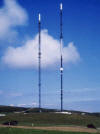 |
VHF/FM Re-engineering, which required a new mast, at Blean Plwyf |
Stereo broadcasting was introduced experimentally, in its present form, from Wrotham in 1962 and by 1972 extended to most of the UK. The re-engineering of the high power transmitters to transmit mixed polarized signals began with services from Wrotham in September 1982.
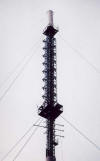 |
An 8 Tier Mixed Polarised VHF/FM antenna erected between an original VHF/FM Slot Antenna and the UHF Cantilever Antenna. |
At all the re-engineered stations the rigid copper main feeders were replaced with corrugated semi flexible feeders thus eliminating the problems associated with the copper feeders.
Throughout the whole of the VHF/FM Radio and TV planning, installation and commissioning there was a happy and fruitful relationship between RD and TCPD, and in particular in respect of antennas.
Return to list of Reminiscences
